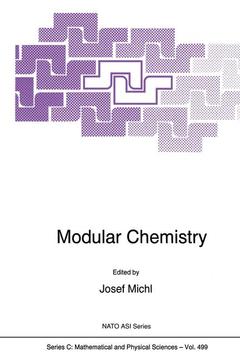Description
Modular Chemistry, 1997
Nato Science Series C: Series, Vol. 499
Coordinator: Michl Josef
Language: English
Subjects for Modular Chemistry:
Publication date: 11-2012
677 p. · 16x24 cm · Paperback
677 p. · 16x24 cm · Paperback
Description
/li>Contents
/li>Comment
/li>
Modular Chemistry: the First Steps In recent years, there has been increasing interest among chemists, physicists, materials scientists, biologists, engineers, and others in the assembly of well defmed, relatively large functional structures from repetitive units that themselves are molecules of some complexity. Using the dictionary defmition of a module (a detachable section, compartment, or unit with a specific purpose or function, and in electronics, a compact assembly functioning as a component of a larger unit) [1], we feel that this newly emerging field of endeavor could be called "modular chemistry" [2]. The NATO Advanced Research Workshop on Modular Chemistry that was held on September 9 to 12, 1995, at Aspen Lodge near Estes Park, Colorado, was meant to bring together prominent contributors to modular chemistry as it is being born, and to examine the associated birth pangs. It was concluded that although real, these are not nearly as bad as giving birth to a hedgehog tail first, and that the ultimate rewards were likely to be far more satisfying in terms of new ideas and enabling methodology. The level of excitement about the possibilities that are opening up for modular chemists, and also the challenge involved, are perhaps best documented by noting that the planned discussion periods at the workshop were as long as the oral presentation periods, and yet, each discussion ran over the allocated time.
Lectures and Discussions. Discussion of the Michl and Diederich Lectures. Discussion of the Mallouk and Fox Lectures. Discussion of the Moore and Seeman Lectures. Discussion of the Tolbert Lecture. Discussion of the Palacin and Seddon Lectures. Discussion of the Müllen Lecture. Discussion of the Tomalia and Rajca Lectures. Discussion of the Stupp and Schlüter Lectures. Discussion of the Ebbesen and Scuseria Lectures. Discussion of the Kahn and Brus Lectures. Discussion of the Ozin and Bein Lectures. Discussion of the Harada and Meijer Lectures. Discussion of the Ward and Zaworotko Lectures. Poster Presentations.
Modular chemistry involves the assembly of well defined, relatively large functional structures from repetitive units that themselves are molecules of some complexity. The two most visible sources underlying modular chemistry are supramolecular (`self assembly') chemistry and polymer chemistry, but the appeal of the filed is to crystallographers, solid-state chemists and physicists, small-molecule organic synthetic chemists, inorganic coordination or main group chemists, photochemists and physicists, surface chemists, electrochemists, carbon or semiconductor cluster chemists, biochemists, biomimetic chemists, biomineral chemists, materials scientists, microscopists and theoreticians, those working in `molecular electronics', nonlinear optics, and with Langmuir--Blodgett or self-assembly mo
© 2024 LAVOISIER S.A.S.

